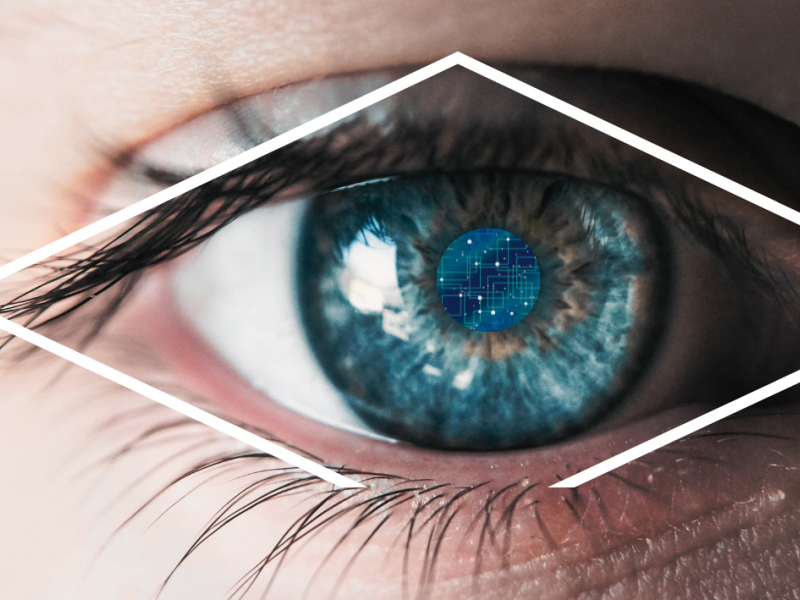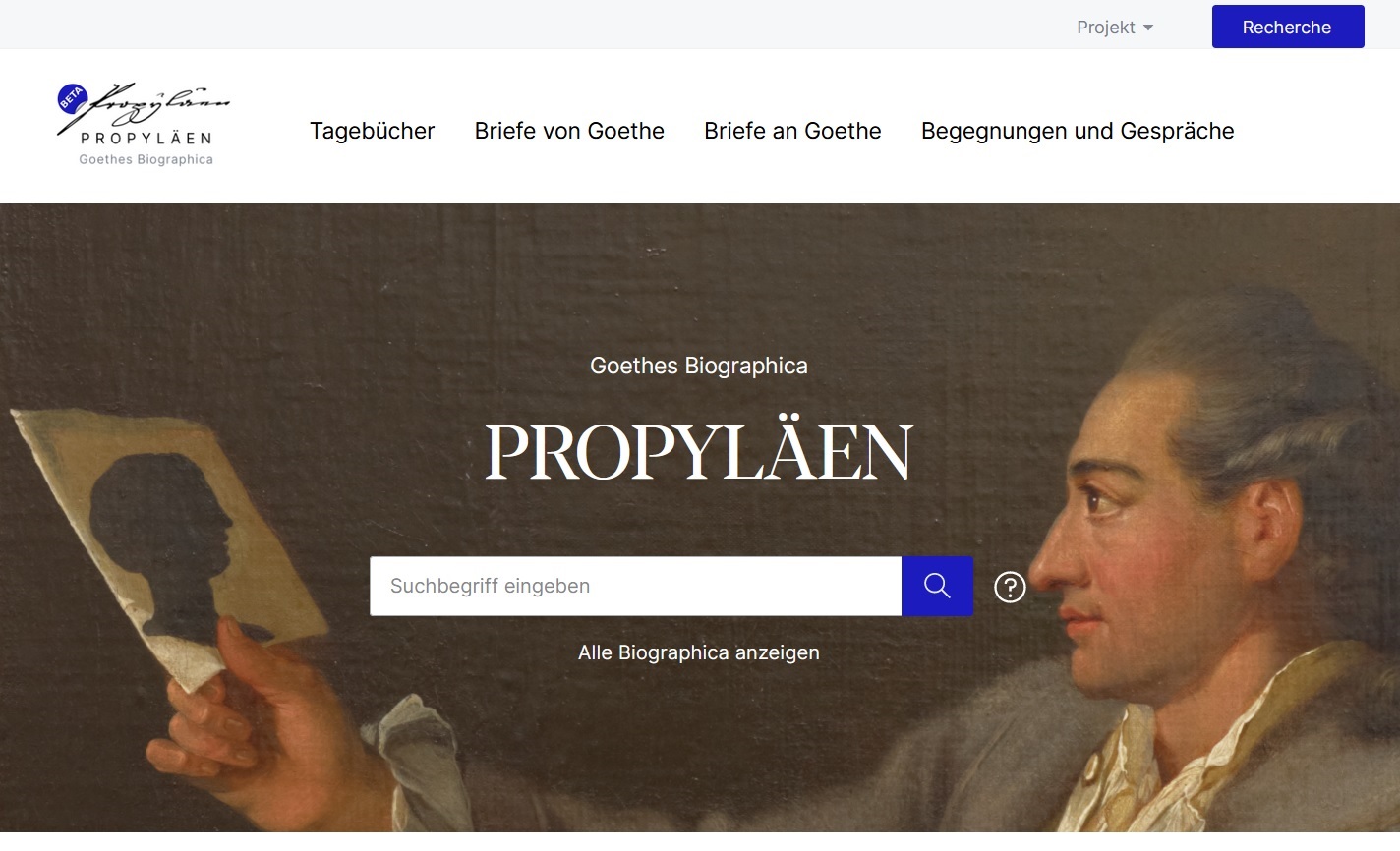Lecture by Jenny Bryś, Claudia Häfner, Christian Thomas (Weimar) in the context of the research colloquium "Digital Perspectives", SoSe 2022
„Die Zeit verschiebt nicht nur die Zwecke, Auch andre Mittel fordert sie.“ Die digitale Edition der „Briefe an Goethe“ innerhalb der PROPYLÄEN. Goethes Biographica

Date:
23.06.2022Place:
Thursdays, 6-8 p.m. c.t., digital via Zoom
Categories:
EventContact:
Dr. Claudia BambergFurther Information:
you tube video recording
The aim of the academy's PROPYLÄEN project is to enable users to find answers to these and many other questions on a central platform - PROPYLÄEN: Goethes Biographica [1]. The hybrid edition combines texts and research data from four traditional editions, the Encounters and Conversations, the Diaries, Letters from and Letters to Goethe. The latter form the content focus of the lecture.
Since 1980, the letters to Goethe have appeared in print in the form of registers. [2] The volumes published from 1995 onwards were entered into a structured text database by means of TUSTEP and brought into typesetting. [3] Thus, all volumes of the Regestausgabe (RA) published to date have been available online since 2003. [4] It thus functions hybrid and follows the single source principle.
The PROPYLÄEN now make it possible to model this structured text database according to TEI P5. In addition, for the first time, the complete transcriptions of the letters are made available to the users, for which a practicable data model is being developed according to their special features. [5] The guidelines of the Text Encoding Initiative (TEI), the international de facto standard for digital editions, will be used. [6] In particular, the specifications of the TEI guidelines in the German Text Archive Basic Format for Manuscripts (DTABf-M) serve as further orientation, [7] as do the mature TEI models of the Weber-Gesamtausgabe, the edition humboldt digital, and other established edition projects. [8] In the field of correspondence-specific metadata, the Correspondence Metadata Interchange Format (CMIF) [9] has become a widely used data model, which is also used in the TEI format of the PROPYLÄEN.
A special feature of the data model is that the TEI headers for the more than 14,000 letters registered to date (RA vols. 1-9, published 1980 to 2018) are retro-digitized and the inclusion of the corresponding metadata follows the strict RA principles. [10] The respective TEI body for the transcriptions, on the other hand, is born digital and the modeling must remain flexible because not all phenomena of the letters and their frequency are known yet. The challenge here lies in the great heterogeneity of the manuscripts of over 3,500 letter writers.
But which philological phenomena are principally considered in the letters to Goethe? How can their selection be justified? And how are they coded in concrete terms? - What aspects of the research data are we currently interested in? And how can we think about the digital future? Is the research data generated today reusable, interoperable and expandable?
[1] Das Projekt befindet sich seit 2015 im Akademienprogramm vgl. www.saw-leipzig.de/propylaeen (alle URLs in diesem Abstract abgerufen am 14.06.2022) und wird in enger Kooperation zwischen der Klassik Stiftung Weimar, der Sächsischen Akademie der Wissenschaften zu Leipzig, der Akademie der Wissenschaften und der Literatur Mainz (Digitale Akademie) sowie dem Freien Deutschen Hochstift in Frankfurt am Main realisiert.
[2] Überblick zur Genese zuletzt bei Christian Hain: Briefe an Goethe und ihre Erschließung. Eine Gesamtausgabe in Regestform, in: Goethe-Jahrbuch 136 (2019), S. 215–236.
[3] Zum Prozess der Retrodigitalisierung siehe Manfred Koltes: Die Regestausgabe der Briefe an Goethe, in: Roland Kamzelak (Hg.): Computergestützte Text-Edition, Tübingen 1999, S. 101–115; ders.: Probleme der Retro-Konversion. Die Regestausgabe der Briefe an Goethe, in: Anne Bohnenkamp, Elke Richter (Hg.): Brief-Edition im digitalen Zeitalter (Beihefte zu editio, Bd. 34), Berlin, Boston 2013, S. 75–86.
[4] Vgl. Briefe an Goethe. Gesamtausgabe in Regestform. Verfügbarer Zeitraum 1764–1822, hg. von der Klassik Stiftung Weimar, Goethe- und Schiller-Archiv in Kooperation mit dem Verlag Hermann Böhlaus Nachfolger, https://ores.klassik-stiftung.de/ords/f?p=403:1.
[5] Erste Überlegungen siehe Jenny Bryś, Claudia Häfner: „Dennoch können Regesten den Abdruck eines Volltextes nicht ersetzen.“ Die digitale Veröffentlichung der Briefe an Johann Wolfgang von Goethe in den Propyläen, in: Denkströme. Journal der Sächsischen Akademie der Wissenschaften zu Leipzig, Heft 22 (2020), S. 59–72, http://www.denkstroeme.de/heft-22/s_59-72_brys-haefner.
[6] https://tei-c.org; aktuelle Richtlinien TEI P5, Version 4.4.0, 2022-04-19 unter https://tei-c.org/release/doc/tei-p5-doc/en/html/index.html.
[7] https://www.deutschestextarchiv.de/doku/basisformat; vgl. dazu Susanne Haaf, Christian Thomas: „Enabling the Encoding of Manuscripts within the DTABf: Extension and Modularization of the Format“, in: Journal of the Text Encoding Initiative [Online], 10 (2017). DOI: https://doi.org/10.4000/jtei.1650.
[8] https://weber-gesamtausgabe.de; https://edition-humboldt.de; weitere Orientierung zur Annotation von Briefen bietet das Handbuch Encoding Correspondence: A Manual for Encoding Letters and Postcards in TEI-XML and DTABf. Edited by Stefan Dumont, Susanne Haaf, and Sabine Seifert, https://encoding-correspondence.bbaw.de/v1.
[9] https://github.com/TEI-Correspondence-SIG/CMIF.
[10] Vgl. Arbeitsgrundsätze für die Gesamtausgabe der Briefe an Goethe in Regestform, in: Gerhard Schmid (Hg.): Bestandserschließung im Literaturarchiv, München u. a. 1996, S. 185–255, abrufbar unter https://www.klassik-stiftung.de/assets/Dokumente/GSA/Benutzung/Weimar_Goethe_Schiller-Archiv_Bestandserschliessung_03.pdf.

